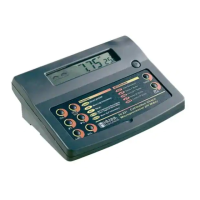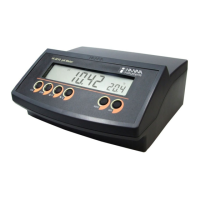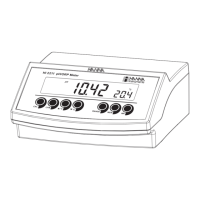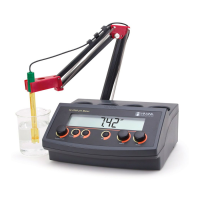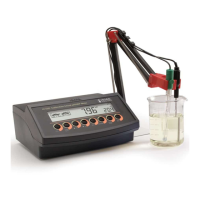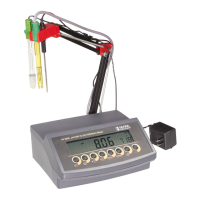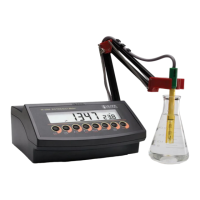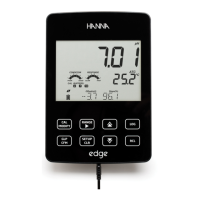9
RELATIVE mV MEASUREMENTS
• Press RANGE until “rEL” message and “mV” tag are displayed for
one second. After one second the temperature will be displayed on
the secondary LCD and the “mV” tag will blink.
The reading displayed by the instrument is equal to the difference
between the current mV input value and relative mV offset established in
the relative mV calibration.
TEMPERATURE MEASUREMENTS
Connect the HI 7662
temperature probe to the
appropriate socket and turn the instrument on.
Submerse the temperature
probe
into the sample
and allow the reading on the secondary LCD to stabilize.
pH CALIBRATION
Calibrate the instrument frequently, especially if high accuracy is
required.
The instrument should be recalibrated:
• Whenever the pH electrode is replaced.
• At least once a week.
• After testing aggressive chemicals.
• If “CAL” “INTV” tags are blinking during measurement.
Every time you calibrate the instrument use fresh buffers and perform an
electrode Cleaning Procedure (see page 38).
PREPARATION
Pour small quantities of the buffer solutions into clean beakers. If
possible, use plastic or glass beakers to minimize any EMC interferences.
For accurate calibration and to minimize cross-contamination, use two
beakers for each buffer solution. One for rinsing the electrode and one for
calibration.
If you are measuring in the acidic range, use pH 7.01 or 6.86 as first
buffer and pH 4.01 as second buffer. If you are measuring in the alkaline
range, use pH 7.01 or 6.86 as first buffer and pH 10.01 or 9.18 as
second buffer.
40
Typical Electrode Life
Ambient Temperature 1 – 3 years
90 ºC Less than 4 months
120 ºC Less than 1 month
Alkaline Error
High concentrations of sodium ions interfere with readings in alkaline
solutions. The pH at which the interference starts to be significant
depends upon the composition of the glass. This interference is called
alkaline error and causes the pH to be underestimated. Hanna’s glass
formulations have the indicated characteristics.
The resistance of glass electrodes partially depends on the temperature.
The lower the temperature, the higher the resistance. It takes more time
for the reading to stabilize if the resistance is higher. In addition, the
response time will suffer to a greater degree at temperatures below 25 ºC.
Since the resistance of the pH electrode is in the range of 50 – 200
Mohm, the current across the membrane is in the pico Ampere range.
Large currents can disturb the calibration of the electrode for many
hours.
For these reasons high humidity environments, short circuits and static
discharges are detrimental to a stable pH reading.
The pH electrode’s life also depends on the temperature. If constantly
used at high temperatures, the electrode life is drastically reduced.
TEMPERATURE CORRELATION
FOR pH SENSITIVE GLASS
1.0 Mol L
-1
Na
+
0.1 Mol L
-1
Na
+
Sodium Ion Correction for the Glass at 20-25 ºC
Concentration pH Error
13.00
13.50
14.00
12.50
13.00
13.50
14.00
0.10
0.14
0.20
0.10
0.18
0.29
0.40
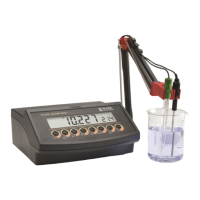
